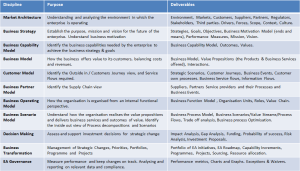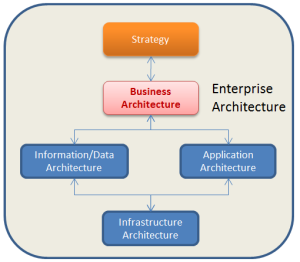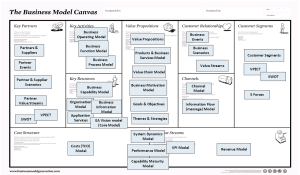http://weblog.tetradian.com/2013/04/28/from-edge-to-backbone/
http://weblog.tetradian.com/2013/04/28/from-edge-to-backbone/
Enterprise Architecture in Spain. ------------------------------------------------------------------------------------------------------- Arquitectura Empresarial en España. ---------------------------------------------------------------------------------------------------- A collection of EA things (post, twits, files, blogs...) I find on the internet (TOGAF, Zachman, PEAF, FEAF, Gartner ...)
More and more, IT is focused on reliability while the business side is pushing for tech innovation and new tech adoption. Enterprise architects and tech execs are right to be cautious about latching on to the next-big-thing, but there’s also little good done by ignoring this unprecedented wave of business interest and “shadow” adoption. Forrester Research analyst Brian Hopkins recently highlighted a handful of areas enterprise architects can stay grounded in their needs while reaching for innovation and agility.
Here are five tips for fostering innovation and agility in EA development as adopted from Hopkins and Forrester’s “Emerging Technology playbook.”

http://www.cmdbuild.org/en/diffusione/convegni-e-workshop/togaf-archi-e-cmdbuildhttp://www.cmdbuild.org/en/diffusione/convegni-e-workshop/togaf-archi-e-cmdbuild
If you have been solution or technical architect, have you ever wondered what would it take for you to become enterprise architect? Have you thought on what is definition of enterprise architect?
Simply speaking, an enterprise architect is a person who is responsible for creating and managing enterprise IT architecture in relation with business capabilities of an organization. One of his sole responsibilities is to ensure the business-IT alignment in a consistent and sustained manner thereby maximizing the ROI on business investments on IT.
What are some of the key activities/tasks undertaken by an enterprise architect?
To successfully perform above activities, he may need to have knowledge or experience working with one of the following frameworks:
He undertakes some of the following activities/tasks to accomplish above mentioned core responsibilities:
He may have to have skills with some of the following tools:
Module 1: What is Business Architecture?
• A day in the life of a business architect
• Definition of a business
• Definition of business architecture
Module 2: Views, Designs and Models
Lesson 1: The fundamental flows in a business
Lesson 2: Vision, business models, and operating models
Lesson 3: Goal Views: Goals, strategies, measures, and timelines
Lesson 4: Process Views: Processes, use cases, and scenarios
Lesson 5: Function Views: Functions and capabilities
Lesson 6: Organization and Financial Views
Workshop: Determine the operating model for Tinkelman
Workshop: Identify processes, capabilities, and plausible org structure for a Tinkelman business. Show the three fundamental flows
Module 3: Finance & Accounting
Why do architects need to know this stuff?
Lesson 1: Basic financial statement analysis
Lesson 2: Business events and financial results
Lesson 3: Project funding models
• Debt vs. equity financing
Lesson 4: Activity based costing
Lesson 5: Measurement of everything else
Workshop: Create two sets of pro-forma financial statements for a Tinkelman project, one showing the effects of the project, the other showing the results if the project is not done. Assuming everything else remains roughly the same, use financial statement analysis to determine whether the project improves Tinkelman’s business conditions.
Module 4: Strategy & Goal Development
Lesson 1: How goals and strategy are related
Lesson 2: A six-step process for developing strategy
• Determine current business model
• Identify potential business models
• Identify competitive necessities (cost, quality, speed, service)
• Identify business focus (customer, product, technology, production capacity)
• Select one business model
• Refine the business model
• Complete the business model
• Identify specific goals
Workshop: Given Tinkelman’s current business, clarify and refine the strategic direction and set strategic goals using the process from this module
Module 5: Process Management and Governance
Lesson 1: Understanding process governance
Lesson 2: Process governance patterns
Lesson 3: Techniques for managing process change
Workshop: Analyze, troubleshoot, and recommend a change to a Tinkelman process
Module 6: Advanced Topics
Lesson 1: Contract as fundamental building block
Lesson 2: Ethical justification for existence (charter to exist granted by state)
Lesson 3: Organizational Patterns
Lesson 4: Troubleshooting
http://aelena.com/blog/2013/04/16/the-many-definitions-of-enterprise-architecture/
Not that there is a scarcity of definitions of Enteprise Architecture ( EA ). You can consider it to be a big depiction (snapshot) as represented by many artifacts, documents, process documentation (although I think this definition comes a bit short). You might say it is a definition (some sort of body of standards that define how processes are designed, built, data is shared – and managed – and projects undertaken according to the bigger picture strategy).
It can be a discipline too (it actually is, insofar as it also is a capacity), affecting also how processes are designed and built, but at a bigger level, from the point of view of the whole enterprise. Its capacity to built and automate processes and services efficiently, aligned to strategy and keeping the eyes on the business and the bottom line.
It seems very hard to convene on a single definition of the term, but probably the most complete and relevant is the one that puts EA in alignment and close to strategy. EA should be a tool that embodies the organization’s capacity for effectively and timely translating a well-defined corporate strategy into a target operating model, while, of course supporting the construction and implementation of that new operating model and its successive evolutions.
So, in relating Enterprise Architecture to Strategic Planning, we can see how they actually are inseparable allies. EA helps enterprises shape their future structure and processes in the face of the fast-changing environments in which they operate. More and more EA should also become relevant the importance of data as an asset (big data too) as the main enabler of decision making. EA should be a tool to help you refine and improve your strategic thinking.

Image from here.
Note that of course, in the absence of sensible strategies, EA itself is not magical solution. Also bear in mind that EA is an ongoing effort (see the five C’s of EA).
It’s interesting to see other definitions of EA
And yet, more definitions I found here.
This can lead to a lot of debating that can degerate on zealot flaming over which is the right defintion. I think this blog entry on EA fundamentalism has quite a point and is an interesting read.
What EA is not, and many people still seem to confuse the things, is enterprise application. The term is probably meant to apply to “big” applications used all over the enterprise (or in significant part of it, or territory), and the confusion might span from the shared “enterprise” word, but EA is not mere IT, it’s not applications.
Hi
http://dl.dropboxusercontent.com/u/12210081/CIO-Conf-FadiHindi-Oct15.pdf
EA is a strategy and business-driven
activity that supports management
planning and decision making by
providing coordinated views of an
entire enterprise.
EA is an emerging practice devoted to
improving the performance of
enterprises by enabling them to see
themselves in terms of holistic and
integrated view.
By developing current and future
versions of its integrated views,
organizations can better manage
change and the transition to the target
operating environment.
http://www.mikethearchitect.com/2013/04/mike-walker-has-joined-hewlett-packard.html
My role as an Enterprise Architecture and Strategy Advisor is broken up into thirds:
Inno.com - Antwerp Area, Belgium
Enterprise architecture (EA) is the process of translating business vision and strategy into effective enterprise change by creating, communicating and improving the key requirements, principles and models that describe the enterprise's future state and enable its evolution.[1] wikipedia
Business Architecture
Canvas
Deliveries
http://ingenia.wordpress.com/2013/03/23/business-architecture/



A leading City Brokerage is seeking a new Senior Enterprise Architect (ADL, IEEE 1471, TOGAF) for their Senior Management Team in charge of improving their strategy and process for the whole of their global organisation. This major brokerage is becoming an exchange and with this change there are a number of changes that need to be made to the security and networking to make sure they meet the regulation requirements.
This leading Broker dealing in Treasury, Equities, Credit and Volatility also have an extensive Market Data division; hover they do not expect you to come from a finance background instead you will need to be a seasoned Enterprise Architect (ADL, IEEE 1471, TOGAF) who has the ability to produce Project Implementation Architecture and the experience of using Architecture Description Languages and the various architectural views/ frameworks.
This role for Enterprise Architect (ADL, IEEE 1471, TOGAF) will be a very challenging and exciting role for the right person who is able to understand and assess a large firm built though merger and acquisitions and to see the challenge as something they are able to bring process to.
The right Enterprise Architect (ADL, IEEE 1471, TOGAF) therefore have key attributes in the following areas:
This is primarily a communicative role where you will use your architectural ability to work on strategy and process moving forward. The successful Enterprise Architect (ADL, IEEE 1471, TOGAF) will have am analytical mind and will want to be in an environment where they can organise globally distributed systems.
Enterprise Architect (ADL, IEEE 1471, TOGAF)
Jobs